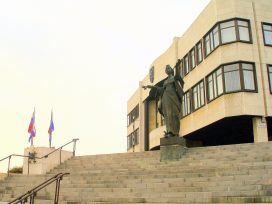Research in the social sciences traditionally links the rise of the extreme right with the political reverberations from social and economic crises. The emergence of right-wing authoritarian regimes in Italy and Germany has been connected to the recession and unemployment of the period following the First World War. Since the 1990s, however, developments on the extreme right have been linked with globalization. Problems like unemployment and security have, in this context, made exclusivist narratives that scapegoat migrants increasingly appealing. But how precisely are crisis and political movements related?
Crisis and movements
Contemporary references to crises resonate with older approaches that described unconventional forms of collective action in terms of ‘crisis behaviour’. Psychological theories understand ‘collective action’ as the sum total of all individual behaviours. They define social movements as manifestations of individuals’ feelings of deprivation and frustrated expectation. Nazism and neo-Nazism have, following this approach, been interpreted in two ways. They are seen, firstly, as aggressive reactions to the sudden and unexpected end of periods of economic wellbeing. The second interpretation sees neo-Nazism stemming from peoples’ raised expectations on a global scale.
Research on the extreme right takes a ‘breakdown’ approach. It considers social, political, and cultural pathologies as causal preconditions for the growth of the radical right. On these accounts, the emergence of political extremism is facilitated by weakened social, familial and communal ties in mass society. Though not applied to progressive movements, breakdown approaches still resonate with interpretations of the extreme right as a reflexive reaction to social crises and unsuccessful integration of individuals into society.
At the macro level, much research singles out specific grievances, like unemployment or the presence of migrants, which have been magnified by general modernization trends or the economic crises contingent upon them. At the individual level, however, social and economic crises are seen as responsible for the development of psychopathology. This favours recruitment by extremist groups. These explanations have been adapted during various phases of research on the issue, from discussions of the rise of extreme right organizations in the 1970s to the so-called ‘third wave’ of rightwing extremism since the 1990s.
The focus on ‘breakdown’ is captured by Harold R. Kerbo’s concept of ‘movements of crisis.’ Kerbo and others have focused on movements in affluent times, especially those developing in advanced democracies with expanding welfare provisions and well-established political parties and representative institutions. While social movements are usually considered to respond to new opportunities for them, they also form in reaction to threats. In Kerbo’s analysis, movements of crisis are sparked during times of political turmoil. They respond to changes in everyday life brought about by unemployment, food shortages, and dislocation. Their participants are, at least in the early stages, mainly beneficiaries of changes. Protests tend, during this time, to be more spontaneous. More often than not, they involve violent outbursts.
Movements of crises are contrasted with ‘movements of affluence’. Unlike movements of crisis, the latter are found during relatively ‘good times’. Members of these groups tend to be spurred into action by their consciences. They are better organized and less likely to use violence. Movements of affluence tend to be stronger, larger, longer-lasting, pragmatic, optimistic, and are more often successful. The opposite is true of movements of crisis, which tend to be weaker, smaller, shorter, radical, pessimistic, and more often unsuccessful.
The regressive characteristics of movements of crisis is described by Karl Polanyi’s concept of ‘countermovements’. In the cyclical oscillation between the free market and social protections, countermovements respond to free market reforms. They defend, instead, a moral economy that recognizes some modicum of social protection. Faced with economic crises, such as the Great Depression, social movements pushed for a reversal of the dominant economic paradigm, from liberalism to interventionist Keynesianism.
While not a central focus of social movement studies, economic strains have been considered an important factor in the development of a movement. This is because ‘protests generally protest against something and we fail to grasp their meaning if we fail to consider what they protest against’. Studies of social movements in the Global South tend to emphasize the importance of economic tensions in prompting protest. Social dislocations are judged to push disadvantaged groups into action, since the loss-averse will accept risks in order to defend their subsistence and everyday lives.
David Snow and his collaborators write of ‘quotidian disruption’. They emphasise the relevance of dislocations that threaten routines that had been taken for granted. As Borland and Sutton have noted in their study of the Argentinian crisis in the early 2000s, the disruption of subsistence routines, as well as the threats to established expectations, increase peoples’ propensity towards collective action frames and identities. When the quotidian is disrupted by, for example, loss of jobs, health, housing and the like, ‘action is inhibited, routine is stymied, and uncertainties emerge’. Casting doubt on taken-for-granted assumptions, these situations make individuals more risk-seeking and ‘powerfully motivated to engage in collective action to reconstitute the quotidian and recoup what they have lost’.
The Great Recession that hit the world in 2008 was a critical juncture, triggering both socioeconomic and political transformations. Some of the political developments during the crisis have challenged civil, political and social rights, triggering a ‘Great Regression’. Increasing social inequality added up to growing mistrust in the established institutions, as economic insecurity began to increase and xenophobia ensued. Scholars debate how much inequality democracies can withstand without breaking down. The backlash is, however, resisted by mobilisation for social justice and ‘real democracy’.
Social scientists have recently described anti-austerity protests, particularly but not only in southern Europe, as progressive movements of crisis that have grown under conditions of deep recession, with cutbacks to the welfare state and de-legitimated representative institutions. Contrary to Kerbo’s definition of movements of crisis, left-leaning anti-austerity protests were able to mobilize broad sectors of the population, mostly remaining peaceful and obtaining both public resonance and political success. Though occasionally backward-looking, they were able to propose alternative visions for deepening democracy.
Some of the aforementioned causes emerged, however, as neither necessary nor sufficient. For example, the extreme right is not always strong where there is high immigration. Conversely, it might often be strong where there is no immigration. The extent to which economic crisis and related grievances mobilise people on the left or right is, then, an open question. Understanding the conditions under which these tensions trigger movements on either side of the political spectrum requires going beyond the assessment of grievances. We need, instead, to analyse the two fronts’ social and political bases, as well as their organisational dynamics.
Status, cleavages and class
Is ‘backlash politics’ the same as ‘status politics’? Social scientists suggest that grievances are often linked to different types of structural conditions in which class and status tend to interact. Social classes have been analysed in detail in research on labour (both ‘blue-collar’ and ‘white-collar’ workers) and on revolutions. Recent research in the Marxist tradition has looked at the political consequences of transformations in class structures, including the financialization of capital, the ‘proletarianisation’ of the middle classes, and the ‘precarisation’ of labour. Links between class-position (within the system of production) and other sociographic characteristics (sex, gender, generation, ethnic background, and education) in the Great Regression era still need to be systematically investigated.
Research on the extreme right has certainly singled out peoples’ concerns about loss of status. At the micro-level, research has addressed the sociographic characteristics of members of extreme right groups (voters, sympathizers, and activists). These studies have found that anomie, social breakdown, relative deprivation, loss of status, and ethnic competition are linked to xenophobia. Seymour Lipset, for example, famously considered the Ku Klux Klan as a product of the resistance of social groups during times of declining status, caused not only by modernisation but also by disorientation, discrepancy, and inconsistency of status, as well as relative deprivation.
Moving from status to cleavage analysis, the extreme right has been considered a successful rebellion of the ‘losers’ of globalization. In particular, Hanspeter Kriesi, Edgard Grande and their collaborators singled out the formation of a cleavage between winners (those who have an ‘exit option’) and losers (those without one). With the erosion of protected property rights and increasing cultural diversity, cultural competition adds up to economic and political competition. A cultural and an economic dimension intersect around an integration-demarcation divide, whereby losers oppose and winners support increased global competition. This evolution is said to be facilitated by the pacification of traditional cleavages around class and religion, high levels of economic development, increasing immigration, and volatility among the electorate.
Initially mobilised on the right, the worldview of the losers is dominated by a cultural demarcation. This is often expressed in the form of exclusivist nationalism. Conflicts over pro-market and pro-state issues become more trenchant, and opposition to cosmopolitan liberalism increases. The growth of the radical right since the 1990s is often taken as a reaction of the losers to economic competition and especially cultural globalisation.
Reactions to globalisation take different forms. On the one hand, as Kriesi and his collaborators put it, ‘The radical left opposition to the opening up of the border is mainly an opposition to economic liberalisation and to the threat it poses to the left’s achievement at the national level. The populist right’s opposition to the opening up of the borders is first of all an opposition to the social and cultural forms of competition and the threat they pose to national identity.’ On the other hand, the success of the extreme right in its ‘mobilisation of the losers’, at least in some party systems, is considered responsible for a shift of centrality from an economic dimension in the 1970s to a cultural one today.
In this analysis, the new cleavage singles out the losers and winners of globalisation. According to Kriesi and his collaborators, ‘the likely winners of globalisation include entrepreneurs and qualified employees in sectors open to international competition, as well as cosmopolitan citizens. Losers of globalization, by contrast, include entrepreneurs and qualified employees in traditionally protected sectors, all unqualified employees, and citizens who strongly identify themselves with their national community.’ The analysis of the positions of the well-educated versus the less educated shows that if education has liberating effects in terms of tolerance and openness, the less educated tend to develop xenophobic cultural positions, as cultural closeness becomes a common denominator for a socially fragmented stratum.
Several studies confirm that some radical-right parties have gained support among blue collar workers. Backlash politics seems, however, to be an inter-class phenomenon. Its participants comprise nationally-specific mixtures of class bases. Generally, in Latin America or Southern Europe, losers have been mobilized on the left by emerging movement parties. In addition, support for backlash positions is strong among various social groups, including the declining middle-class or even upper classes. The latter are among the main funders of backlash politics as well as present among their voters. Understanding the class or status bases of backlash movements and its politics requires, however, a more specific analysis of the class structure of their supporters as well as the interaction between class background and generational, gender, and ethnic identities.
Neoliberal backlash
To understand backlash politics as crisis politics, we need to look into the specific characteristics of ‘late neoliberalism’. Late neoliberalism is the dominant economic form during the Great Recession, experienced in different countries and macro-regions. The different forms of neoliberalism share an emphasis on the free market without social protections, and all variants have produced increasing inequality as well as decreasing support for institutions. Late neoliberalism, however, added austerity measures as a way to address the financial crisis created by deregulation policies. Neoliberal policies, including privatization, liberalization, and deregulation-cum-austerity, had similar characteristics, reducing the state’s capacity to fulfil its promises to its citizens. Today’s unequal distribution of wealth is, as a result of the addition of austerity policies, similar to that of the end of the late nineteenth century, as the rate of return on capital is greater than economic growth. High inequality, in turn, produces social and political instability, often with dramatic existential effects in terms of disruption to everyday life.
Within the global evolution of the financial crisis, inequality appeared at different times and with different characteristics in different countries, influenced by pre-existing structural conditions as well as contingent developments. The variables that are usually mentioned include the size of the public debt and its composition, public deficits, the relationship between private debt and savings, the financing of debt through domestic versus foreign financial institutions, balance of payments, and the competitiveness of the economy. The timing and speed of the manifestation of the Great Recession can also be expected to have consequences on backlash politics.
The Great Recession transformed class structures, shrinking the middle class and ‘precarising’ labour. The concept of class has, as a consequence, re-emerged in debates on progressive social movements. Within the world-systems approach, for example, the concept of ‘anti-systemic movements’ defines broad reactions to exploitation within world capitalism. This approach builds on an analysis of ‘the world-system of historical capitalism’, arguing that ‘class and status consciousness were the two key concepts that justified these movements’. World system theorists expect increasing protests as exploitation grows: ‘when oppression becomes particularly acute, or expectations particularly deceived, or the power of the ruling stratum falters, people have risen up in an almost spontaneous manner to cry halt’. The exploitation of the periphery allows the hegemonic capitalist country to survive, since at the core of the capitalist world-system, extra profits can be invested by granting some benefits to labour. State protection and mercantilist policies thus ‘increasingly transferred world capitalist competition from the realm of relations among enterprises to the realm of relations among the states’. According to proponents of the world-systems approach, the task of anti-systemic movements was to resist greedy capitalism, opposing the logic of the system. As Immanuel Wallerstein noted, ‘to be anti-systemic is to argue that neither liberty nor equality is possible under the existing system and that both are possible only in a transformed world’.
The world-systems approach said little, however, about how context shapes those movements’ emergence and their eventual forms. Recent research has addressed the effects on the class structure of capitalist transformation, including the development of most extreme forms of exploitation. Research on the class bases of anti-austerity protests has singled out broad cross-national diversity, but more empirical evidence is needed to compare anti-systemic movements on the Right and the Left.







